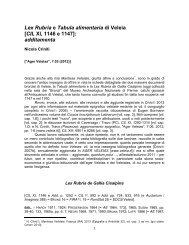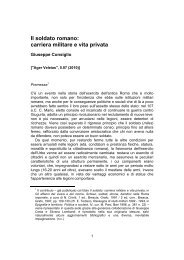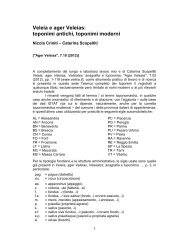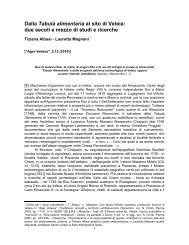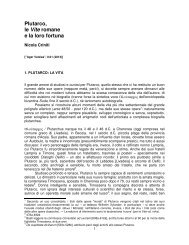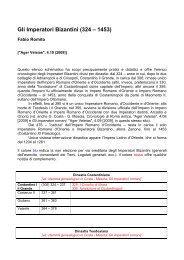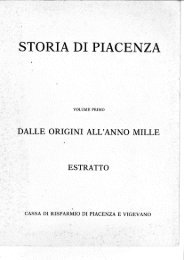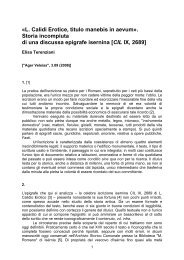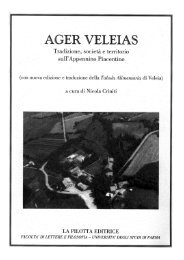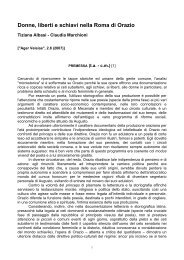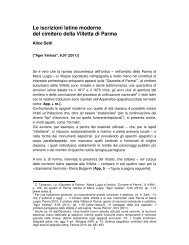Rogo Christe, tibi laudes? - ager veleias
Rogo Christe, tibi laudes? - ager veleias
Rogo Christe, tibi laudes? - ager veleias
You also want an ePaper? Increase the reach of your titles
YUMPU automatically turns print PDFs into web optimized ePapers that Google loves.
trasmessa al proconsole: violando i precetti degli Imperatori e dei Cesari essi celebrarono<br />
collectam sive dominicum. L’utilizzo del termine collecta potrebbe non essere casuale e<br />
lascerebbe supporre la stesura del testo da parte di una mano donatista. Tilley ritiene che<br />
il termine, adottato nelle passiones donatiste, altro non sia che una tipologia della<br />
assemblea di Israele. “Like the early collecta, the Donatist faced the temptation to<br />
assimilate, to follow in the footsteps of the Catholics who supported the oppressive<br />
government of the Roman Empire” 80 .<br />
Ha inizio così l’interrogatorio da parte del proconsole al martire Dativo, che, come già era<br />
avvenuto nel foro d’Abitina, forse in ragione della sua posizione sociale ha la precedenza.<br />
Le domande e le risposte non sono però state riportate che in forma sintetica e indiretta:<br />
proconsul Dativum interrogat cuius esset condicionis et utrum collectam fecissent. Qui<br />
cum se christianum et in collecta fuisse profiteretur, auctor ab ipso collectionis<br />
sanctissimae postulatur. Il redattore decise di sopprimere la lunga serie di domande e<br />
risposte 81 con le quali solitamente si aprivano i processi e delle quali abbiamo<br />
testimonianza grazie ai testi rimasti più fedeli ai verbali processuali, come gli Acta<br />
Martyrum Scilitanorum e la Passio Crispinae.<br />
Il proconsole intima a Dativo di confessare chi fosse il promotore dell’adunanza: segue<br />
l'ammissione di Dativo, desunta dall’agiografo dal resoconto stenografico sul quale dovette<br />
lavorare e non riportata con le testuali parole del martire, d’esser cristiano e d’aver preso<br />
parte alla cerimonia. Anullino ordina, senza perdere tempo, all’officium di applicare il<br />
martire all’eculeo così da esser pronto per l’ungulatio, ovvero perchè le sue carni vengano<br />
tormentate dagli uncini 82 .<br />
Il redattore descrive indi l’azione dei carnefici: cum carnifices iussa... complerent<br />
starentque saevientes in dictis et denudatis ad vulnera martyris lateribus erectis ungulis<br />
imminerent. Franchi de’ Cavalieri propone di modificare in dictis con in digitis sulla base di<br />
alcune concordanze nell’espressione rinvenute in autori classici 83 . Egli “propose de<br />
corriger la leçon saevientes in dictis en in digitis. Cela donnerait indiscutablement un sens<br />
préférable: les bourreaux exécutaient les ordres cruels avec une rapiditè farouche, «leurs<br />
80 Tilley, The Bible, p. 55-65<br />
81 Le domande che le autorità erano solite rivolgere così da inquadrare gli imputati erano: Quis vocaris? -<br />
Cuius condicionis es? – Cuius dignitas es? A queste talvolta si aggiungeva la richiesta di altre<br />
informazioni, come l’età: Quot annorum es? (Cfr. Passio SS. Maximae, Donatillae et Secundae 2)<br />
82 “In the pain of torture, the jailers uses the capacity for sentience to obliterate any object in the world of<br />
sense perception outside the body. The victim comes to experience her or his own body not as the object<br />
of torture but as the instrument of torture. As the victim undergoes more and more pain, the conceptual<br />
world of the victim shrinks until even the place of detention no longer exists. Nothing exists but a body in<br />
pain.” (Tilley, The Ascetic, p.469)<br />
83 Cfr. Franchi de’ Cavalieri, La Passio, p. 14 nota 3<br />
35



